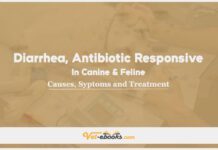Aspergillosis In Canine and Feline: Causes, Symptoms and Treatment

Overview
An opportunistic fungal infection caused by Aspergillus spp., which are common molds found everywhere in the environment.They produce spores in various places like dust, straw, grass clippings, and hay. Disseminated disease causes localized (nasal cavity and frontal sinuses) or disseminated disease in both dogs and cats
Causes of Aspergillosis In Canine and Feline
- Aspergillosis disease is typically caused by A. terreus or A. deflectus, although other Aspergillus species have also been reported.
- A. fumigatus causes nasal or lung disease but usually doesn’t spread throughout the body.
- Sinoorbital aspergillosis has been observed in cats and can be caused by various species, including Aspergillus felis.
- German shepherd dogs, dogs of purebred lineage, are more susceptible when immunosuppressed.
- Certain geographic and environmental factors may contribute, as some areas experience a higher occurrence of this condition.
- In cats, this condition has been associated with feline infectious peritonitis (FIP), feline panleukopenia virus, feline leukemia virus (FeLV), diabetes mellitus, and chemotherapy.
Pathogenesis of Aspergillosis In Canine and Feline
- The exact entry point for the infection hasn’t been definitively determined, but it’s likely through the respiratory or gastrointestinal tract, followed by spreading through the bloodstream.
- This infection most commonly affects intervertebral discs, bones, thoracic lymph nodes, the lungs, and the renal pelvis. In some cases, it can be limited to the respiratory system (bronchopulmonary aspergillosis), or rarely, affect the cornea or ear canal, often involving Aspergillus species other than A. terreus or A. deflectus.
Symptoms (History & Physical Examination) of Aspergillosis In Canine and Feline
History
Dogs:
- Dogs are more frequently affected compared to cats.
- German shepherds have a higher occurrence, but cases have been infrequently reported in various other breeds.
- On average, the condition appears at around 3 years of age (with a range from 1 to 9 years), with a slight prevalence in females.
Cats:
- Persian cats exhibit a slightly elevated occurrence of this condition.
- It primarily affects the respiratory and/or gastrointestinal systems.
- It is linked to feline infectious peritonitis (FIP), feline panleukopenia virus (FPV), feline leukemia virus (FeLV), feline immunodeficiency virus (FIV), diabetes mellitus, and the prolonged use of corticosteroids and antibiotics.
Physical Examination
Dogs:
- Onset can be sudden or gradual over several months.
- Lameness is characterized by fungal osteomyelitis, resulting in localized pain and swelling.
- Neurological symptoms may include fungal discospondylitis leading to paraparesis, paraplegia, spinal pain, and central signs such as vestibular issues, circling, seizures, hemiparesis, mental dullness, ataxia, and vision impairment.
- Renal involvement may manifest as increased urination and thirst, vomiting, reduced appetite, and weight loss.
- Respiratory symptoms could include coughing, increased respiratory effort, and reduced lung sounds due to pleural effusion.
- Cardiac issues may lead to irregular heart rhythms.
- Gastrointestinal problems can result in abdominal distension, loss of appetite, vomiting, and diarrhea.
- Ocular symptoms may involve uveitis, chorioretinitis, hyphema (bleeding in the eye), and panophthalmitis (severe inflammation of the eye).
- Nonspecific signs may encompass fever, weight loss, weakness, vomiting, and swollen lymph nodes.
Cats:
- Typically, the signs observed in cats are nonspecific, such as lethargy, vomiting, and diarrhea.
- Ocular symptoms may include exophthalmos (bulging eyes).
Diagnosis of Aspergillosis In Canine and Feline
1- From History and Physical Examination
2- Diagnostic Procedures
DIAGNOSTIC METHODS
The choice of the sampling site depends on the clinical symptoms but could involve procedures such as collecting cerebrospinal fluid (CSF) through a tap, obtaining aspirates from intervertebral disc spaces, abdominocentesis or thoracocentesis, as well as aspirating various organs like the spleen, liver, kidneys, or lymph nodes.
PATHOLOGICAL OBSERVATIONS
- The presence of hyphae that exhibit a 45-degree branching pattern, with specialized stains aiding in the detection of the organism.
- The identification of focal osteomyelitis with multiple pale granulomas occurring in organs such as the kidneys, spleen, lymph nodes, myocardium, pancreas, and liver.
- The occurrence of pyogranulomatous inflammation in multiple body parts including the lungs, eyes, thyroid, uterus, brain, and prostate. This inflammation consists of numerous septate, branching hyphae, some of which may display distinctive lateral branching aleuriospores (as seen in A. terreus).
- Optimal visualization is achieved through staining techniques like periodic acid-Schiff, Gomori’s methenamine silver, or Crocott’s stain.
CBC/BIOCHEMISTRY/URINALYSIS
- These tests provide general information but are not specific to the condition.
- CBC:
In dogs, you may observe mature neutrophilic leukocytosis, occasionally with eosinophilia and monocytosis. About one-third of affected dogs may have normocytic, normochromic, nonregenerative anemia.
In cats, nonregenerative anemia and leukopenia may be present.
- Biochemistry results may show varying levels of hyperglobulinemia and increased levels of alkaline phosphatase (ALP), alanine aminotransferase (ALT), and amylase. Additionally, there may be elevated concentrations of serum creatinine, phosphate, blood urea nitrogen (BUN), and calcium.
- Urinalysis may reveal isosthenuria, microscopic hematuria, pyuria, and the presence of fungal hyphae in the sediment.
OTHER LABORATORY TESTS
- Detection methods include cytology, culture, and histopathology.
- A definitive diagnosis is achieved through fungal culture from normally sterile body fluids and tissues, such as urine, bone, cerebrospinal fluid (CSF), blood, lymph nodes, pleural effusions, and intervertebral disc aspirates. Urine culture is positive in 50% of dogs.
- Culture on Sabouraud’s dextrose agar typically takes 5-7 days.
- Antibody serology is not very sensitive for diagnosing disseminated aspergillosis.
- The Galactomannan antigen ELISA test (urine or serum) shows good sensitivity (89%) and specificity (89%). However, pulmonary and ocular infections may have lower sensitivity, and false positives can occur in dogs treated with Plasmalyte or in cases of other mycotic infections (Penicillium, Paecilomyces, Cladosporidium, Geotrichum, Histoplasma, Cryptococcus).
- In cats, it is advisable to test for feline leukemia virus (FeLV) and feline immunodeficiency virus (FIV).
IMAGING
- Spinal X-rays may reveal end-plate lysis, productive lesions with bridging spondylosis, and vertebral body lysis.
- Osteomyelitis in the diaphyseal region of long bones may display features like bony proliferation, lysis, and periosteal reaction.
- Pulmonary involvement is rare but can include a mixed interstitial/alveolar pattern, enlarged sternal and/or tracheobronchial lymph nodes, pleural effusion, and productive and destructive lesions of sternebrae. Dogs with chronic pulmonary localization may also develop cavitary pulmonary lesions.
- Ultrasonographic Findings: Kidneys are the most common site for detecting changes, which may include renal pelvis dilation with echogenic debris, loss of corticomedullary distinction, renal distortion with mottled parenchyma, dilation of the proximal ureter, renomegaly, nodules or masses, and hydronephrosis.
- The spleen may exhibit hypoechoic, lacy, well-defined areas with no Doppler signal (indicative of infarcts), nodules or masses, mottled parenchyma, and splenic venous thrombosis.
- Other findings may involve abdominal lymphadenomegaly, diffuse hepatic hypoechogenicity, ascites, or evidence of venous thrombosis.
- MRI is useful for further characterizing brain lesions in animals with central nervous system (CNS) abnormalities. The changes observed are similar to those seen in other infectious and noninfectious inflammatory brain diseases. MRI may also help identify subtle vertebral lesions in dogs with discospondylitis.
3- Differential Diagnosis
- Bacterial bone and spinal infections (osteomyelitis/discospondylitis).
- Tumors affecting the spine.
- Conditions related to intervertebral discs.
- Bone tumors.
- Kidney inflammation due to bacteria (pyelonephritis).
- Lung infections caused by bacteria (pneumonia).
- Other factors contribute to balance and seizure problems.
- Additional reasons for uveitis (refer to Anterior Uveitis in Cats and Dogs).
Treatment of Aspergillosis In Canine and Feline
General
- Treatment is seldom curative and generally leads to partial clinical improvement or the cessation of clinical symptom progression. Dogs that are severely affected have a bleak prognosis.
- Fluid therapy should be administered based on the assessment of the dog’s fluid volume status and the extent of renal impairment.
- In cases of dogs with cavitary lesions but no evidence of dissemination, successful treatment has been achieved through pulmonary lobectomy followed by systemic antifungal therapy.
- For disseminated cases in cats, treatment is expected to be challenging, and there is limited available data on its effectiveness.
Medications:
- The preferred treatment approach involves a combination of Itraconazole (given orally at a dose of 5-10 mg/kg once daily or divided every 12 hours) and Amphotericin B (administered intravenously to dogs at a dose of 2-3 mg/kg, three times a week for 9-12 treatments, reaching a cumulative dose of 24-27 mg/kg).
- In some cases, using itraconazole alone has resulted in remission for several months to 1-2 years in a small number of dogs.
- Newer triazole drugs, such as voriconazole and posaconazole, have demonstrated effectiveness against Aspergillus. Some dogs treated with these drugs have achieved remission for extended periods. It’s important to note that Aspergillus species and other molds are inherently resistant to fluconazole, so it should not be employed for treatment.
- Terbinafine (given orally at a dose of 5-10 mg/kg once daily), either alone or in combination with triazoles, has been used to address resistant infections, although its benefits in such cases are not entirely clear.
- β-glucan synthase inhibitors like caspofungin, micafungin, and anidulafungin have limited clinical data in dogs but have proven effective in treating invasive aspergillosis in humans.
- Combination of flucytosine (administered orally at a dose of 25-50 mg/kg every 6 hours for dogs) along with amphotericin B could potentially lead to a successful treatment outcome. However, there are no published reports or studies available to provide documented evidence of its effectiveness.
Some Notes:
- Amphotericin B should not be used in dogs with pre-existing kidney problems or renal failure.
- The use of amphotericin B lipid complex has significantly reduced the risk of kidney damage.
- Oral azole medications may lead to side effects like nausea, occasional loss of appetite, and elevated liver enzyme levels.
- Combining flucytosine and amphotericin B can result in skin reactions in dogs.
- It is advisable to avoid the use of midazolam and cisapride in combination with azole medications, as fatal drug reactions have been observed in humans.
- High-dose itraconazole (10 mg/kg) may cause ulcerative dermatitis in 5-10% of dogs. Early recognition and discontinuation are important, followed by potential reinitiation at a lower dose to prevent severe skin and subcutaneous issues.
- Regularly monitor with serial radiographs every 1-2 months, assess renal function, and conduct urine cultures.
- The prognosis for disseminated aspergillosis, especially in German Shepherd dogs, is generally poor.
- Long-term systemic therapy with itraconazole may help alleviate clinical symptoms in cases of disseminated aspergillosis, although it rarely leads to a complete cure.
Do You Want To Increase Your Veterinary Knowledge and Practical Skills?
You Can Now Browse and Download +3000 Books For Veterinary Professionals & Students Online.
Download Veterinary Books
















